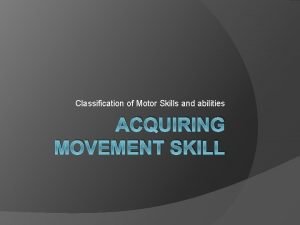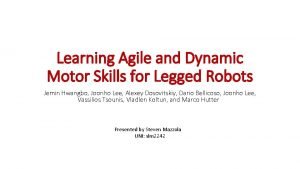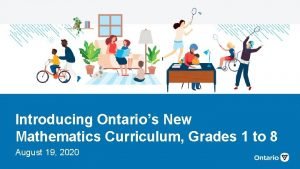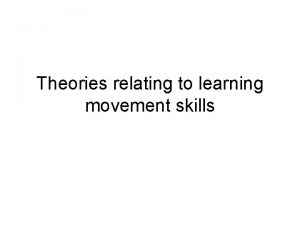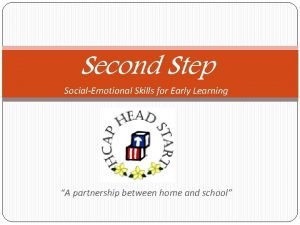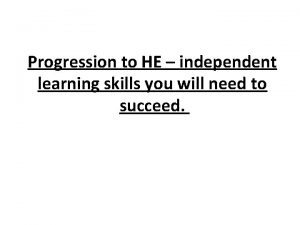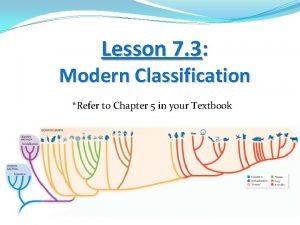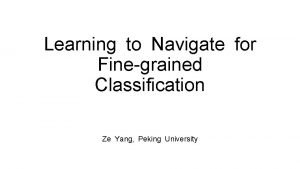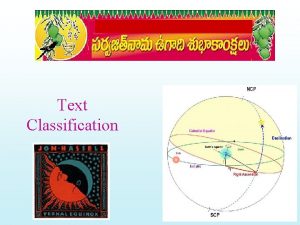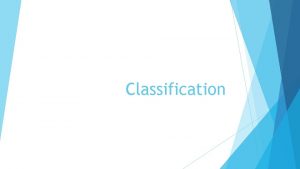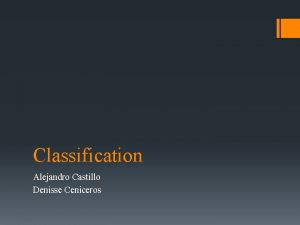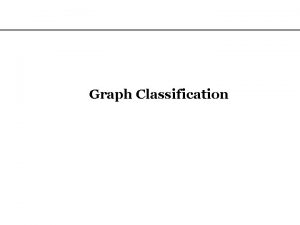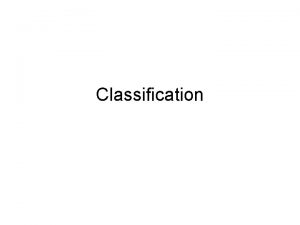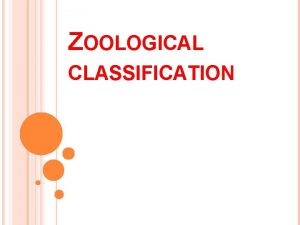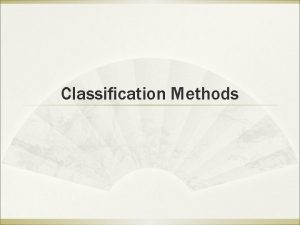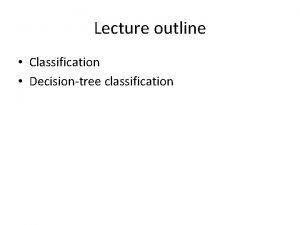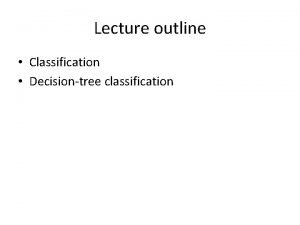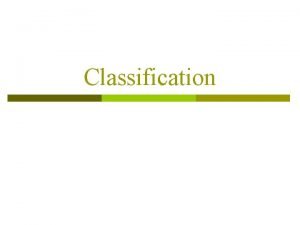3 2 1 1 Classification of skills Learning
















- Slides: 16

3. 2. 1. 1 - Classification of skills Learning objectives To be able to describe the different types of skill classification. To be able to categorise sporting events on one of four different skill classification continuum. To understand the types of goals set by performers.

Classification of skills How are sports skills classified?

Classification of skills Skill differs from ability in that it is not innate, skills are learnt. They are developed from ability after a period of practice. To produce a skilled performance, the player must practise so that the required abilities are enhanced.

Classification of skills Skills are usually classified on a sliding scale called a continuum. This is a visual guide to indicate where a skill fits into a specific category.

Skill Classification – Basic/Simple & Complex A complex skill involves a high level of decision making and has a large cognitive or thinking element to it. COMPLEX Simple skills have a limited amount of information to process. The skill has a smaller cognitive element. BASIC/SIMPLE Think. Pair. Share - Can you name other skills and where would they fit on the continuum?

Skill Classification – Open/Closed An open skill is one that is affected by the sporting environment. The performer has to make decisions in response to their surroundings. A closed skill involves less decision making because it has a predictable environment. The performer can take their time to execute the skill. OPEN CLOSED Think. Pair. Share - Can you name other skills and where would they fit on the continuum?

Skill Classification – Self paced/externally paced A self-paced skill is at the control of the performer. The rate of execution is decided before execution. SELF-PACED An externally paced skill is controlled by factors out of the control of the performer, who may have to react to external conditions. i. e. games activities. EXTERNALLY-PACED Think. Pair. Share - Can you name other skills and where would they fit on the continuum?

Skill Classification – Gross/fine A fine skill has small, delicate muscle movements. FINE A gross skill uses large muscle group movements. GROSS Think. Pair. Share - Can you name other skills and where would they fit on the continuum?

Skill Classification Open/Closed Continuum: This continuum represents the degree with which a skill is open or closed. Open skill ________________ Closed skill Think. Pair. Share - Where would you place the following sports on the continuum?

Skill Classification Analyse and justify reasoning for each of your choices below. Think. Pair. Share – Are the image above open/closed, gross/fine, basic/complex and self or externally paced?

Types of goals Goal setting motivates performers and keeps them working hard. This gives them a better chance of improve fitness levels. Reaching your goals means progress is being made in your training.

Types of goals Outcome Goal: Linked to an end result. i. e. Winning a fencing competition Performance goal: Concerned with previous personal bests with no comparison to others. i. e. To score more goals than last month/season.

Apply it! What has stuck with you? Define what is meant by the open/closed continuum in skill classification. Describe the different gross and fine skill classifications. Classificatio n of skill What is the difference between basic and complex skills? Explain the terms outcome and performance goals.

Practice it! Exam questions 1. Sports skills can be classified as open or closed skills. Explain how a coach would vary a training session when coaching open and closed skills. (3) 2. Classify the skill of marathon running using each of the following classifications: • basic/complex • open/closed • self-paced/externally-paced • gross/fine. Explain your choices. (4)

Practice it! Marks Scheme: 1. If a skill is closed (like a penalty) practice should be in closed conditions (1), however, if it is an open skill, the skill should be practised in pressured situations (1) so the player/team get used to using the skill under pressure of time/opposition (1). If a skill is open (like a pass during the game) practice should be in open conditions (1) it should be practised using variable practice (1) so the player/team get used to adapting the execution of the skill to match the changing circumstances of the game (1). Knowing whether a skill is open or closed means that the coach can set up appropriate drills in training (1), this means that the players would practise closed skills in closed conditions to match the way they need to perform the skill in the game (1), this allows the performer to focus on the skill without unnecessary distractions from others (1).

Practice it! Marks Scheme: 2. Basic – repeated action which requires little thought or cognitive ability / perception (1) Closed skill – repeated running action largely unaffected by the environment / other runners (1) / Accept Open skill if linked to changing environment of runners moving positions / changing position on the road to avoid others) Self-paced – the speed / pace / rate of the movement is controlled by you / when running a long distance race, you decide how fast to run (1) / Accept externally-paced if linked to responding to a pace maker / other runners dictating the pace Gross – involves big movements of the body / involves the use of large muscle groups / movements when running do not tend not to rely on accuracy and precision (1)
 Cuadro comparativo de e-learning b-learning y m-learning
Cuadro comparativo de e-learning b-learning y m-learning Intra personal skills
Intra personal skills Skills
Skills Ontario skills passport
Ontario skills passport Motor skills classification
Motor skills classification Learning agile and dynamic motor skills for legged robots
Learning agile and dynamic motor skills for legged robots Ontario report card learning skills
Ontario report card learning skills Describe the cognitive theory of learning movement skills
Describe the cognitive theory of learning movement skills Second step social emotional skills for early learning
Second step social emotional skills for early learning Independent learning skills checklist
Independent learning skills checklist Olass - offender learning and skills service
Olass - offender learning and skills service Growing success 2010
Growing success 2010 Eager learner vs lazy learner
Eager learner vs lazy learner Characteristics of tabulation
Characteristics of tabulation Traditional classification vs modern classification
Traditional classification vs modern classification Learning to navigate for fine-grained classification
Learning to navigate for fine-grained classification Multi task learning nlp
Multi task learning nlp




